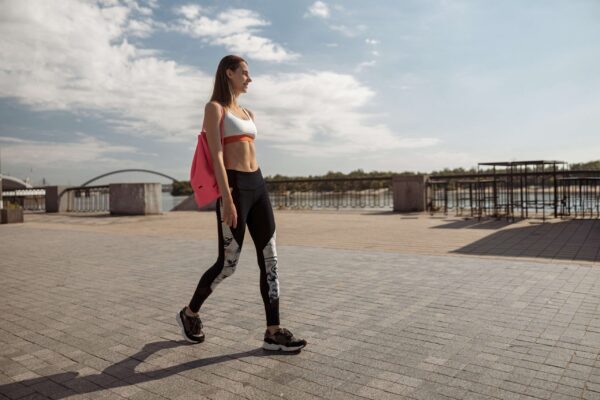Walking is the simplest, most accessible exercise, yet its fitness potential is often underestimated. If you’re stepping out the door for a casual stroll or embarking on a structured walking plan, these tips will help you turn daily steps into meaningful health gains. From goal-setting to gear selection, cross-training to injury prevention, here’s everything you need to know to get fit with walks.
How It Works
Walking blends gentle, low-impact movement with meaningful cardiovascular benefits, making it the perfect entry point for beginners and a reliable staple for experienced exercisers. A steady, brisk pace raises your heart rate into the moderate-intensity zone: about 50–70% of its maximum, which helps you hit the recommended 150 minutes of aerobic activity each week. Beyond the physical lift, stepping outdoors for just 20–30 minutes can slash stress hormones by up to 25% and improve mood by nearly 20%, thanks to increased endorphin and endocannabinoid release.
Because walking puts far less strain on knees and hips than higher-impact activities, it preserves joint health while steadily building endurance. Covering roughly 10,000 steps per day burns about 300–400 calories, an amount that, when paired with balanced nutrition, supports long-term weight management without drastic diets or punishing workouts. Continuous, mindful strides not only strengthen your heart and muscles but also lay the groundwork for sustainable fitness and well-being.
Start Smart
Embarking on a walking journey without direction can lead to frustration or stalled progress. To make every step count, it’s essential to understand where you’re starting, where you want to go, and how quickly you can safely get there. By taking a few simple measurements up front and setting clear, achievable goals, you’ll build confidence and momentum from day one. A structured approach not only prevents burnout but also makes it easier to celebrate each milestone along the way.
- Track Your Starting Point: Use a pedometer or smartphone app to log your average daily steps, typical walking pace, and any hills or inclines you navigate.
- Define Success: Choose specific, measurable goals—perhaps walking 5 km without stopping, hitting an 8,000-step daily average, or completing a 10 km charity event.
- Gradual Progression: To avoid overuse injuries, limit increases in distance or time to no more than 10 percent per week, giving your body time to adapt.
By following these steps, you establish a realistic roadmap and ensure steady improvement. As you regularly revisit your data and adjust your objectives, you’ll stay motivated and injury-free, setting the stage for a lifetime of healthy walking habits.
8-Week Progressive Plan
A structured schedule keeps you accountable and ensures you build fitness safely. Aim to repeat each week’s goals for two consecutive weeks before stepping up to the next level, this gives your body time to adapt and reduces injury risk.
- Weeks 1–2: Three walks per week, 20 minutes each (approximately 1.5–2 km), at an easy, conversational pace to establish a base.
- Weeks 3–4: Increase to four walks per week, 30 minutes each (around 2.5–3 km), at a brisk, moderate intensity to boost cardiovascular fitness.
- Week 5: Five walks per week, 35 minutes each, and introduce one interval session, add a single one-minute burst of faster walking to challenge your stamina.
- Week 6: Maintain five walks plus add one cross-training session (e.g., cycling or swimming) for 40 minutes; seek out hills or inclines to strengthen legs.
- Week 7: Step up to six walks per week, 45 minutes each, and blend steady-paced outings with interval efforts for a balanced stimulus.
- Week 8: Enjoy a recovery week with four easy walks, 20–25 minutes each, at roughly half the load, allowing your muscles to rebuild and refresh.
By the end of this eight-week cycle, you’ll have steadily increased endurance, leg strength, and walking speed, ready for longer hikes, charity events, or simply an active, healthy lifestyle.
Essential Gear & Technique
Having the right gear and mastering basic technique transforms a simple walk into a safe, efficient workout. Quality equipment protects your body from discomfort and injury, while correct form ensures you get the most benefit from every stride. From the soles of your feet to the load on your back, each element plays a crucial role in comfort, performance, and long-term joint health.
Key Elements:
- Footwear & Apparel: Choose walking shoes with cushioned midsoles, firm heel counters, and flexible forefoot support. Proper fit prevents blisters and reduces fatigue. Pair them with moisture-wicking socks to keep feet dry, and wear lightweight, breathable layers that wick sweat and allow ease of movement. Reflective accents or bright colors improve visibility during early-morning or dusk outings.
- Walking Poles: Using one or two poles shifts approximately 25% of your body weight off your knees and onto your arms, reducing joint stress and boosting upper-body engagement. Poles also enhance stability on uneven terrain, help you power up inclines, and can improve overall walking posture by keeping your torso aligned.
- Backpack Basics: A well-designed walking pack features a padded waist belt and adjustable sternum strap to transfer weight onto your hips, preventing shoulder and back strain. Aim to carry no more than 10% of your body weight, enough for essentials like water, snacks, and a windbreaker, so you stay balanced and agile on varied surfaces.
Equipped with the proper gear and the confidence to use it, you’ll walk farther, faster, and more comfortably. As you progress, continually assess your equipment and technique, small adjustments can unlock greater performance and keep you motivated for the long haul.
Ready, Set, Walk!
Every journey begins with a single step, and in this case, that step can change your life. Walking is a celebration of movement, an invitation to discover your own strength, and a gentle reminder that fitness doesn’t require extremes. With each daily stroll, you’re nurturing your cardiovascular health, sharpening your mind, and building resilience. You’re also joining a community of women who understand that real transformation comes from consistency, not perfection.
Before you head out, remember to prepare wisely: select supportive footwear that cushions your soles, layer for comfort, and pack a hydration source if you’ll be out longer than 30 minutes. Follow your progressive plan at your own pace, repeat weeks when needed, then courageously step up your challenge when you feel ready. Lean on your fellow walkers for accountability, celebrate every milestone, and take advantage of rest weeks to replenish your energy. Now is the moment to step outside, inhale deeply, and welcome the healthiest version of you.


